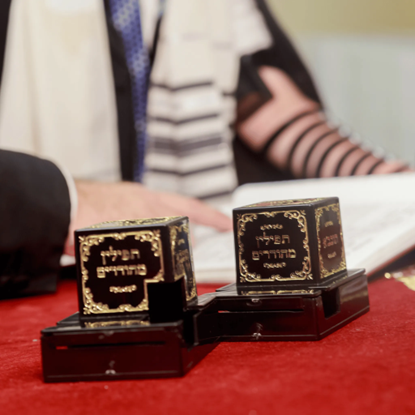Elevating Joy to Kdusha; The Mitsva Of Simcha
הרב שי טחןכב ניסן, תשפה20/04/2025אפילו בהסתרה שבתוך ההסתרה
תגיות:שמחהמצווההסתר פנים
Chazal teach us "משנכנס אדר מרבין בשמחה"—when the month of Adar arrives, we increase in joy (Taanit 29a). The reason for this is that Adar is the month in which the miraculous salvation of Purim took place, when the Jewish people were saved from Haman's decree of annihilation (Rashi). This joy is not limited to Purim itself but extends throughout the entire month, as the transformation from potential destruction to redemption is a cause for ongoing happiness.
A question arises: Since we have a Torah obligation to be happy, as the pasuk states (Devarim 28:47) that curses come upon those who do not serve Hashem with joy, this teaches that one must always be happy—not only in the month of Adar. Why, then, did Chazal specifically emphasize increasing joy in Adar? What, then, is the reason for Chazal’s specific instruction to increase our joy now?
states (Devarim 28:47) that curses come upon those who do not serve Hashem with joy, this teaches that one must always be happy—not only in the month of Adar. Why, then, did Chazal specifically emphasize increasing joy in Adar? What, then, is the reason for Chazal’s specific instruction to increase our joy now?
To answer this, we must first analyze the Torah commandment we just mentioned. There are different ways it has been explained, but let us focus on two seemingly contradictory approaches.
The Joy of Fulfilling Mitzvot
Rabbeinu Bechayei, one of the Rishonim, explains that there are two separate elements: the actual performance of a mitzvah and the joy in performing it. As a result, he states that there are two rewards—one for the mitzvah itself and another for the happiness experienced while performing it, as joy is considered an independent merit.
Hence, since the mitzvah and happiness are two separate aspects, the punishment for lacking joy is not directly tied to the mitzvah itself but rather stems from failing to fulfill the distinct mitzvah of serving Hashem with happiness.
However, Rav Chaim Vital(הקדמה לשערי מצוות) , the greatest student of the Arizal, offers a very different perspective. He raises a question based on the statement of Chazal that one who performs a mitzvah is rewarded in this world and granted longevity. If so, he asks, why do we see people who perform mitzvot yet do not seem to receive this reward? His answer is fascinating: he explains that the reason is that these mitzvot were performed without joy, and that lack of happiness blocked the reward. This implies that joy is not merely an enhancement but an essential component that allows the mitzvah to shine and take effect.
The Arizal himself expresses a similar idea (Sefer Haredim in the introduction, also mentioned few places in the Shla)—that happiness enhances and expands the mitzvah. The greater one’s joy, the greater the mitzvah becomes. This can be compared to a balloon: the mitzvah is like the balloon itself, while happiness is the air blown into it. A balloon without air remains lifeless and deflated, but the more air that is blown into it, the larger and more vibrant it becomes. Similarly, the more joy one infuses into a mitzvah, the greater its impact and spiritual significance.
According to this approach, a person may fulfill a mitzvah perfectly, adhering to every detail, but if they do so without happiness—merely as an obligation to check off and move on with their day—the mitzvah remains unrewarded.
The joy in Avodat Hashem is mentioned in many places, such as the obligation to rejoice on the chagim in celebration of the day or to be happy when getting married. However, all these expressions of happiness are tied to a specific mitzvah. What, then, is the reason for our joy in Adar? Is it merely because, many generations ago, we experienced a miracle?
The Joy of Closeness to Hashem
The answer lies in the pasuk: "נגִילָה וְנִשְׂמְחָה בָּךְ"—"Let us rejoice and be glad in You." This teaches us that our joy is not dependent on any external reason, but rather, it stems from our closeness to Hashem.
The midrash (Shir Hashirim) explains: Rabbi Avin said: "We do not know whether the rejoicing is in the day itself or in Hashem." Thus king Shlomo came and clarified: "Let us rejoice and be glad in You"—meaning, the rejoicing is in Hashem.
Therefore, the difference between the joy of performing mitzvot and the joy of Adar is fundamentally distinct. In Adar, our happiness is not derived from the performance of mitzvot but from the mere fact of our unbreakable bond with Hashem.
Another layer to understanding this is the idea that Chazal teach: "There is no greater happiness than the resolution of doubt." The story of Purim exemplifies this concept perfectly. The Jewish people faced total annihilation, yet, in a sudden turn of events, their enemies were the ones who were destroyed. This dramatic reversal revealed Hashem’s absolute control over world events, even when everything seemed lost, and all hope appeared to be gone.
At first glance, the story of Purim seems entirely natural, with no open miracles. However, when the Jews pieced together the sequence of events, they could no longer doubt that everything had been orchestrated by Hashem’s providence. This realization—that even in the darkest times, Hashem is guiding every detail—brought them the greatest joy.
Thus, true joy does not stem from external circumstances or miraculous salvations but from the clarity of recognizing Hashem’s presence in our lives. When doubt is removed and one sees that everything is in Hashem’s hands, there is no greater happiness. The joy of Adar, therefore, is not merely about commemorating a past miracle—it is about embracing the certainty that Hashem is always with us, orchestrating every step of our journey.
Adar Has Good Mazal
Let us delve deeper into the words of Chazal, who state that Adar is a month of strong mazal for the Jewish people.
The term mazal (מַזָּל) is often translated as "luck" or "fortune," but in Jewish thought, it carries a much deeper meaning. It refers to the flow of divine influence that affects the world and individuals, often associated with celestial forces. The Gemara (Shabbat 156a) discusses how the constellations and heavenly bodies play a role in the natural order, yet ultimately, the Jewish people are believed to be above mazal—meaning that through tefillah, teshuvah, and mitzvot, they can transcend natural influences by connecting directly with the Creator.
This concept is famously expressed in the phrase "Ein Mazal L’Yisrael"—there is no astrological influence over Israel. This suggests that, despite astrology or the belief in the influence of certain times, the destiny and success of the Jewish people are determined solely by Hashem’s will rather than by celestial forces.
However, if this is the case, Chazal’s statement that Adar is a month of strong mazal seems contradictory. The Ritva resolves this by explaining that, while the Jewish people are generally not bound by astrological forces, the month of Adar is an exception. During this time, Hashem’s providence is channeled through the mazalot (constellations), granting the Jewish people an added measure of success.
This, however, raises a question: If the essence of Adar is about experiencing a direct connection with Hashem, why would its special influence come through the mazalot rather than directly from Him?
The answer might align with our explanation above: although in Adar we are under the influence of the mazalot, and events may seem to follow natural causes, Hashem is still behind it all. This teaches us that even in dark times, when it appears as though Hashem is hidden and everything unfolds naturally, we must recognize that nature itself—just like the constellations—is entirely controlled by Hashem.
A question arises: Since we have a Torah obligation to be happy, as the pasuk

To answer this, we must first analyze the Torah commandment we just mentioned. There are different ways it has been explained, but let us focus on two seemingly contradictory approaches.
The Joy of Fulfilling Mitzvot
Rabbeinu Bechayei, one of the Rishonim, explains that there are two separate elements: the actual performance of a mitzvah and the joy in performing it. As a result, he states that there are two rewards—one for the mitzvah itself and another for the happiness experienced while performing it, as joy is considered an independent merit.
Hence, since the mitzvah and happiness are two separate aspects, the punishment for lacking joy is not directly tied to the mitzvah itself but rather stems from failing to fulfill the distinct mitzvah of serving Hashem with happiness.
However, Rav Chaim Vital(הקדמה לשערי מצוות) , the greatest student of the Arizal, offers a very different perspective. He raises a question based on the statement of Chazal that one who performs a mitzvah is rewarded in this world and granted longevity. If so, he asks, why do we see people who perform mitzvot yet do not seem to receive this reward? His answer is fascinating: he explains that the reason is that these mitzvot were performed without joy, and that lack of happiness blocked the reward. This implies that joy is not merely an enhancement but an essential component that allows the mitzvah to shine and take effect.
The Arizal himself expresses a similar idea (Sefer Haredim in the introduction, also mentioned few places in the Shla)—that happiness enhances and expands the mitzvah. The greater one’s joy, the greater the mitzvah becomes. This can be compared to a balloon: the mitzvah is like the balloon itself, while happiness is the air blown into it. A balloon without air remains lifeless and deflated, but the more air that is blown into it, the larger and more vibrant it becomes. Similarly, the more joy one infuses into a mitzvah, the greater its impact and spiritual significance.
According to this approach, a person may fulfill a mitzvah perfectly, adhering to every detail, but if they do so without happiness—merely as an obligation to check off and move on with their day—the mitzvah remains unrewarded.
The joy in Avodat Hashem is mentioned in many places, such as the obligation to rejoice on the chagim in celebration of the day or to be happy when getting married. However, all these expressions of happiness are tied to a specific mitzvah. What, then, is the reason for our joy in Adar? Is it merely because, many generations ago, we experienced a miracle?
The Joy of Closeness to Hashem
The answer lies in the pasuk: "נגִילָה וְנִשְׂמְחָה בָּךְ"—"Let us rejoice and be glad in You." This teaches us that our joy is not dependent on any external reason, but rather, it stems from our closeness to Hashem.
The midrash (Shir Hashirim) explains: Rabbi Avin said: "We do not know whether the rejoicing is in the day itself or in Hashem." Thus king Shlomo came and clarified: "Let us rejoice and be glad in You"—meaning, the rejoicing is in Hashem.
Therefore, the difference between the joy of performing mitzvot and the joy of Adar is fundamentally distinct. In Adar, our happiness is not derived from the performance of mitzvot but from the mere fact of our unbreakable bond with Hashem.
Another layer to understanding this is the idea that Chazal teach: "There is no greater happiness than the resolution of doubt." The story of Purim exemplifies this concept perfectly. The Jewish people faced total annihilation, yet, in a sudden turn of events, their enemies were the ones who were destroyed. This dramatic reversal revealed Hashem’s absolute control over world events, even when everything seemed lost, and all hope appeared to be gone.
At first glance, the story of Purim seems entirely natural, with no open miracles. However, when the Jews pieced together the sequence of events, they could no longer doubt that everything had been orchestrated by Hashem’s providence. This realization—that even in the darkest times, Hashem is guiding every detail—brought them the greatest joy.
Thus, true joy does not stem from external circumstances or miraculous salvations but from the clarity of recognizing Hashem’s presence in our lives. When doubt is removed and one sees that everything is in Hashem’s hands, there is no greater happiness. The joy of Adar, therefore, is not merely about commemorating a past miracle—it is about embracing the certainty that Hashem is always with us, orchestrating every step of our journey.
Adar Has Good Mazal
Let us delve deeper into the words of Chazal, who state that Adar is a month of strong mazal for the Jewish people.
The term mazal (מַזָּל) is often translated as "luck" or "fortune," but in Jewish thought, it carries a much deeper meaning. It refers to the flow of divine influence that affects the world and individuals, often associated with celestial forces. The Gemara (Shabbat 156a) discusses how the constellations and heavenly bodies play a role in the natural order, yet ultimately, the Jewish people are believed to be above mazal—meaning that through tefillah, teshuvah, and mitzvot, they can transcend natural influences by connecting directly with the Creator.
This concept is famously expressed in the phrase "Ein Mazal L’Yisrael"—there is no astrological influence over Israel. This suggests that, despite astrology or the belief in the influence of certain times, the destiny and success of the Jewish people are determined solely by Hashem’s will rather than by celestial forces.
However, if this is the case, Chazal’s statement that Adar is a month of strong mazal seems contradictory. The Ritva resolves this by explaining that, while the Jewish people are generally not bound by astrological forces, the month of Adar is an exception. During this time, Hashem’s providence is channeled through the mazalot (constellations), granting the Jewish people an added measure of success.
This, however, raises a question: If the essence of Adar is about experiencing a direct connection with Hashem, why would its special influence come through the mazalot rather than directly from Him?
The answer might align with our explanation above: although in Adar we are under the influence of the mazalot, and events may seem to follow natural causes, Hashem is still behind it all. This teaches us that even in dark times, when it appears as though Hashem is hidden and everything unfolds naturally, we must recognize that nature itself—just like the constellations—is entirely controlled by Hashem.
הוסף תגובה
עוד מהרב שי טחן
עוד בנושא מוסר








